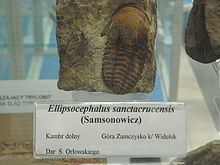Scientific name Ellipsocephalus Rank Genus | Family Ellipsocephalidae Higher classification Ellipsocephalidae | |
 | ||
Similar Paradoxides, Conocoryphe, Eccaparadoxides, Ptychoparia, Paradoxides gracilis | ||
Trilobites ellipsocephalus hoffi
Ellipsocephalus is an extinct genus of blind trilobite that lived during the Cambrian. The genus comprises benthic species inhabiting deep, poorly lit or aphotic habitats. E. hoffi is a common trilobite mainly from central Europe (Czech Republic).
Contents
- Trilobites ellipsocephalus hoffi
- Ellipsocephalus trilobite
- Etymology
- Distribution
- Description
- Behaviour
- References
Ellipsocephalus trilobite
Etymology
Ellipsocephalus is the contraction of ellipse (from Greek ἔλλειψις elleipsis, "falling short") and cephalus (Greek: Κέφαλος Kephalos, "head") for the rounded headshield that is wider than long.
Distribution
Description
Ellipsocephalus is approximately oval in shape and definitely convex, and it has opistoparian sutures that are directed slightly outward from the front and the back of the eyes. The central raised area of the headshield (or cephalon) called glabella has approximately parallel sides that are slightly concave and a rounded front. Lateral furrows are indiscernible, as is the occipital ring. The ridges connecting the eye with the glabella (or palpebral lobes) are not distinctly separated from the thin eye ridges. The area between the front of the glabella and the border is somewhat inflated. The free cheeks (or librigenae) are half as wide as the fixed cheek. Some species have genal spines (like E. sanctacrucensis), while the most known species (E. hoffi) has a slightly angular genal angle. Ellipsocephalus has 12 thorax segments. The tailpiece (or pygidium) is 4× wider than long.
Behaviour
Ellipsocephalus and some other primitive micropygous Cambrian genera, such as Bailiella, enroll differently from other trilobites so that the posterior thorax segments and pygidium bend under the thorax. This is called "double enrollment".
